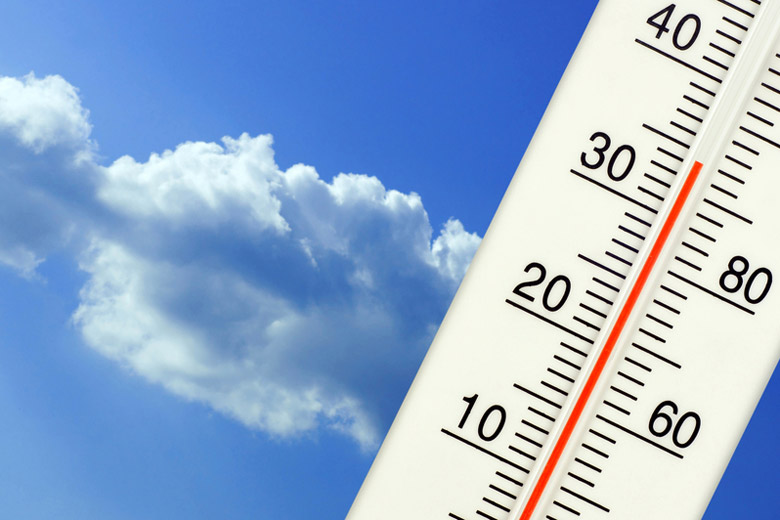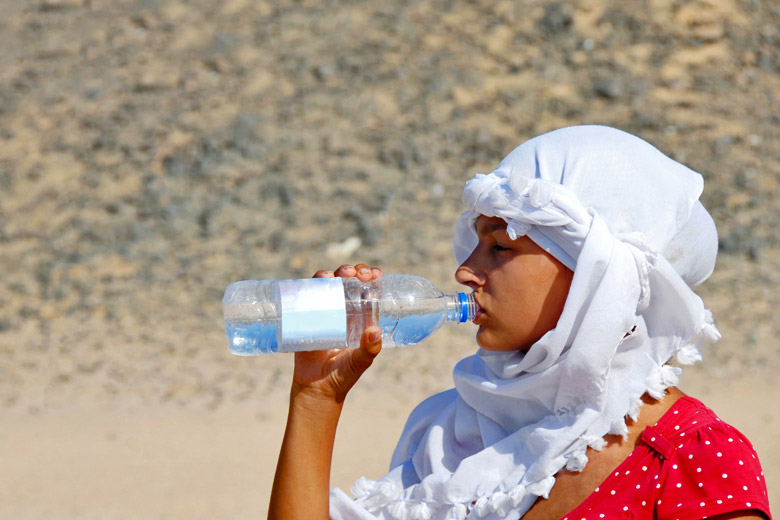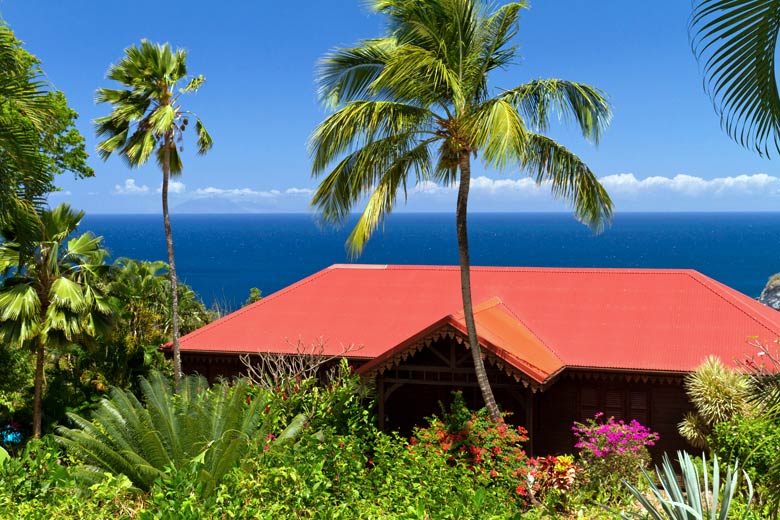Heat & humidity levels calculator
Our heat and humidity calculator is here to help you find the perfect holiday destination while avoiding any extreme heat and humidity that could create discomfort.
Understanding how heat and humidity works is a complicated business, so read our guide to find out more about how we measure heat and humidity, as well as to see where in the world experiences crippling levels of heat and humidity at certain times of the year.
- Heat and humidity calculator
- About heat and humidity
- Heat and humidity: where and when?
- Heat and humidity by month

Heat and humidity calculator: average level for your holiday
Air temperature on its own is not necessarily the best indicator of how hot the weather may feel in your chosen holiday destination. For example, the resort of Sharjah just 12 miles north of Dubai, can feel quite tolerable in April even though the air temperature is normally in the low thirties.
At the same time, Pattaya in Thailand can feel unbearably hot when the temperature there is exactly the same as in Sharjah. The difference can be explained by the level of water vapour in the air - the humidity.
To help you find the right destination, we have created a heat and humidity calculator that takes the average air temperature and humidity to create a heat and humidity index (more about this below).
This shows the level of discomfort that is likely to be encountered at each destination when a combination of high air temperatures and high levels of humidity can make it feel unbearably hot.
Understanding the heat and humidity index
The system we use for our heat and humidity calculator, and for our climate guides, comes from a formula that was developed by researchers who put people to the test. They subjected volunteers to different levels of temperature and humidity, before asking them to describe how they felt.
An index was then created from these results, and this is the one we use. The index breaks heat and humidity down into five levels of intensity, from none to extreme, and the results we display for each destination are based on 30 years' worth of temperature and humidity data.
| Icon | Level | Description |
|---|---|---|
 |
None | No discomfort; it does not feel too hot |
 |
Low | Slight discomfort; some might feel the heat and humidity |
 |
Moderate | Moderate discomfort; everyone will feel the heat and humidity |
 |
High | High sense of discomfort; everyone will feel the increased heat and humidity |
 |
Very High | Very high sense of discomfort; conditions feel very hot and close |
 |
Extreme | Extreme sense of discomfort; conditions can feel unbearably hot |
About heat and humidity
We humans naturally regulate our body temperatures, so when we get too hot, we sweat. This perspiration then evaporates, which helps us to cool down. As air temperature rises, the difference between body temperature (roughly 37°C) and the air temperature narrows.

If you're in a fairly dry environment, such as the Sahara Desert, this is not a problem, as your sweat can still evaporate at low levels of humidity even if the temperature is high.
As long as you keep replacing the water that evaporates off your skin by staying hydrated, you can maintain a normal body temperature in a desert when the air around you is at a higher temperature.
However, in a less dry environment where humidity is higher, feelings of discomfort start to occur because the body's evaporation process works less efficiently in more humid conditions, which makes maintaining normal body temperature far more difficult.
Did you know?As air temperature rises, its capacity to hold water vapour increases. In fact, at 35°C the air can hold 75% more water vapour than it does at 25°C
One way of expressing the level of humidity in the air is to use the percentage figure that shows the actual amount of water vapour compared to the maximum possible at that temperature - this is known as relative humidity.
Yes, for a given temperature, air can only contain a certain amount of water vapour; when the maximum is reached it condenses as dew or forms fog.
Sticking with Sharjah, in April it has an average maximum daytime temperature of 33°C and relative humidity of 35%, which according to the heat and humidity calculator produces a moderate level of discomfort.
At the same time the average maximum daytime temperature in Pattaya is also 33°C but the relative humidity is usually between 55% and 60%, which the heat and humidity calculator shows will produce an extreme level of discomfort.
Below 24°C most people can cope with all levels of relative humidity that they are likely to come across without feeling uncomfortably hot. This is because there is sufficient difference between 24°C and normal body temperature for the body not to become overheated.
Heat and humidity: where and when?
Heat and humidity will always be at its peak in the summer months of the destination you're in, which could be anything from April to September in the northern hemisphere, and November to February in the southern hemisphere.

There are fewer destinations in the southern hemisphere that experience extreme levels of heat and humidity, really only certain parts of Australia. This is because in South America, for example, there are high mountains in the west, and in the east you are never far from the cool South Atlantic.
It's a similar story in southern Africa, which has a cold ocean to the south and high elevations inland. As a rough guide, you will find that the following destinations endure extreme levels of heat and humidity at these times of year:
| Month | Destination(s) |
|---|---|
| January | Parts of Australia (Western Australia; Northern Territory) |
| February | Parts of Australia (Western Australia; Northern Territory), north eastern Kenya |
| March | North eastern Kenya |
| April | Thailand, Cambodia, Burma, parts of India, |
| May | Thailand, Cambodia, Burma, parts of India, parts of Oman |
| June | Dubai, Persian Gulf, Oman, parts of India |
| July | Dubai, Persian Gulf, Oman, Upper Egypt, parts of India, USA (southern Arizona; southwest California) |
| August | Dubai, Persian Gulf, Oman, Upper Egypt, USA (southern Arizona; southwest California) |
| September | Dubai, Persian Gulf, Oman |
| October | Oman, parts of Australia (Northern Territory) |
| November | Parts of Australia (Western Australia; Northern Territory) |
| December | Parts of Australia (Western Australia; Northern Territory) |
How heat and humidity affects you will, of course, be different to the next person however, it is vital that you know roughly what to expect for your next holiday to avoid any disappointment, let alone discomfort.
Our heat and humidity calculator is designed to guide you in the right direction for what is acceptable to you, and hopefully you also have clear understanding of how we have measured and reported on heat and humidity around the world, throughout the year.
If our heat and humidity calculator alone isn't enough to help you decide on your ideal holiday destination, then check out the other guides in our detailed holiday weather series including how to plan for tropical storms, where to find warm sea temperatures and tips for avoiding UV damage, among others.
If you have a specific destination in mind, head over to the climate guide section to see the annual weather averages as well as the upcoming five-day forecast. You can also get booking via the travel and discounts section, with the latest offers from airlines and holiday companies.
More holiday weather parameters:
- Daylight hours
- Days with some rainfall
- Maximum daytime temperature
- Minimum night-time temperature
- Monthly rainfall
- Sea temperature
- Sunshine hours
- UV index (maximum)
Heat & Humidity by month
Below is the heat & humidity levels for popular holiday destinations around the world by month. Select a month to see top destinations or search by name to see all months.
Heat & Humidity in January
- Kenyan Coast
- Bali
- Kerala
- Phuket, Thailand
- Maldives
- Goa
- Barbados
- Dominican Republic
- Chiang Mai, Thailand
- Jamaica
- Cape Town
- Dubai
- Benidorm
- Costa del Sol
- Cyprus
- Fuerteventura
- Gran Canaria
- Ibiza
- Lanzarote
- Majorca
- Malta
- Sharm el Sheikh
- Tenerife
Heat & Humidity in February
- Kenyan Coast
- Kerala
- Phuket, Thailand
- Bali
- Maldives
- Sri Lanka
- Goa
- Chiang Mai, Thailand
- Barbados
- Dominican Republic
- Jamaica
- Cape Town
- Dubai
- Luxor, Egypt
- Benidorm
- Costa del Sol
- Cyprus
- Fuerteventura
- Gran Canaria
- Ibiza
- Lanzarote
- Majorca
- Malta
- Sharm el Sheikh
- Tenerife
Heat & Humidity in March
- Kenyan Coast
- Maldives
- Bali
- Sri Lanka
- Cancun
- Dominican Republic
- Barbados
- Jamaica
- Dubai
- Luxor, Egypt
- Miami
- Orlando
- Sharm el Sheikh
- Algarve
- Benidorm
- Costa del Sol
- Cyprus
- Fuerteventura
- Gran Canaria
- Ibiza
- Lanzarote
- Majorca
- Malta
- Morocco
- Tenerife
Heat & Humidity in April
- Bali
- Cancun
- Barbados
- Seychelles
- Dominican Republic
- Dubai
- Jamaica
- Mauritius
- Miami
- Orlando
- Sharm el Sheikh
- Morocco
- Algarve
- Benidorm
- California
- Costa del Sol
- Cyprus
- Gran Canaria
- Ibiza
- Lanzarote
- Majorca
- Malta
- Tenerife
Heat & Humidity in May
- Dubai
- Cancun
- Bali
- Orlando
- Miami
- Sharm el Sheikh
- Mauritius
- Morocco
- Antalya
- Bodrum
- Cyprus
- Marmaris
- Rhodes
- Benidorm
- Malta
- Rome
- Costa del Sol
- Crete
- Tenerife
- Tunisia
- Algarve
- Ibiza
- Lanzarote
- Majorca
- Santorini
Heat & Humidity in June
- Dubai
- Orlando
- Bali
- Sharm el Sheikh
- Antalya
- Bodrum
- Marmaris
- Cyprus
- Rhodes
- Malta
- Benidorm
- Corfu
- Crete
- Rome
- Tunisia
- Costa del Sol
- Naples
- Santorini
- Ibiza
- Gran Canaria
- Barcelona
- Majorca
- Algarve
- Tenerife
- Fuerteventura
- Lanzarote
- Nice
Heat & Humidity in July
- Dubai
- Orlando
- Antalya
- Maldives
- Egypt's Red Sea
- Montenegro
- Bali
- Malta
- Cyprus
- Benidorm
- Costa Blanca
- Tunisia
- Corfu
- Rhodes
- Zanzibar
- Calabria
- Hawaii
- Florence
- Tuscany
- Sicily
- Croatia
- Milan
- Dubrovnik
- Campania
- Italian Lakes
- Naples
- California
- Costa del Sol
- Crete
- Puglia
- Costa Almeria
- Ibiza
- Albania
- Menorca
- North Macedonia
- Majorca
- Boston
- Bulgaria
- Mykonos
- Algarve
- Provence
- Barcelona
- Sardinia
- Santorini
- Sunny Beach
- Venetian Riviera
- Gran Canaria
- Italian Riviera
- Costa Brava
- Costa Dorada
- Tenerife
- Lanzarote
- Hungary
- South of France
- Toronto
- Dordogne
- Slovenia
- Corsica
- Austria
- Vienna
- Bosnia and Herzegovina
- Loire Valley
- Dolomites
- Italian Alps
- Paris
- Azores, Portugal
- Madeira
- Poland
- Krakow
- London
- Belgium
- Alberta
- Amsterdam
- Blackpool
- British Columbia
- Brittany
- Channel Islands
- Cornwall
- Cotswolds
- Denmark
- Devon
- Dorset
- Estonia
- Faroe Islands
- Finland
- French Alps
- Iceland
- Ireland
- Lake District
- Latvia
- Lithuania
- Netherlands
- Normandy
- Northern Ireland
- Northumberland
- Norway
- Peak District
- Pyrenees
- Scotland
- Somerset
- Suffolk
- Sweden
- Switzerland
- Wales
- Western Australia
- Yorkshire Dales
Heat & Humidity in August
- Dubai
- Orlando
- Malta
- Benidorm
- Montenegro
- Bali
- Tunisia
- Cyprus
- Corfu
- Rhodes
- Zanzibar
- Croatia
- Ibiza
- California
- Costa Almeria
- Costa del Sol
- Los Angeles
- Tuscany
- Crete
- Naples
- Majorca
- Menorca
- Gran Canaria
- North Macedonia
- Costa de la Luz
- New York
- Albania
- Algarve
- Sardinia
- Tenerife
- Costa Dorada
- Lanzarote
- Santorini
- Bulgaria
- Corsica
- Nice
- Budapest
- Hungary
- Slovenia
- Bosnia and Herzegovina
- Sarajevo
- Austria
- Northern France
- Italian Alps
- Germany
- Poland
- Alberta
- Amsterdam
- Belgium
- Cambridge
- Channel Islands
- Cornwall
- Denmark
- Devon
- Dorset
- East Sussex
- Edinburgh
- Faroe Islands
- Iceland
- Ireland
- Isle of Wight
- Kent
- Lake District
- Latvia
- Lithuania
- Netherlands
- Norfolk
- Northern Ireland
- Northumberland
- Peak District
- Pembrokeshire
- Pyrenees
- Scotland
- Somerset
- Suffolk
- Switzerland
- Vancouver
- Yorkshire Dales
Heat & Humidity in September
- Dubai
- Orlando
- Bali
- Morocco
- Antalya
- Tunisia
- Marmaris
- Cyprus
- Bodrum
- Malta
- Benidorm
- Rhodes
- Gran Canaria
- Corfu
- Ibiza
- Costa del Sol
- Montenegro
- Tenerife
- Lanzarote
- Rome
- Majorca
- Algarve
- Crete
- Lisbon
- Naples
- Tuscany
- North Macedonia
- Albania
- Madrid
- Nice
- Austria
- Belgium
- Bosnia and Herzegovina
- Cambridge
- Channel Islands
- Cornwall
- Denmark
- Devon
- Dorset
- East Sussex
- Edinburgh
- Faroe Islands
- Germany
- Iceland
- Ireland
- Isle of Wight
- Italian Alps
- Johannesburg
- Kent
- Lake District
- Latvia
- Lithuania
- Netherlands
- Norfolk
- Northern France
- Northern Ireland
- Northumberland
- Peak District
- Pembrokeshire
- Poland
- Pyrenees
- San Francisco
- Scotland
- Slovenia
- Somerset
- Suffolk
- Switzerland
- Yorkshire Dales
Heat & Humidity in October
- Oman
- Dubai
- Thailand
- Gambia
- Barbados
- Dominican Republic
- Goa
- Bali
- Caribbean Coast, Mexico
- Zanzibar
- Kerala
- Luxor
- Maldives
- Jamaica
- Sri Lanka
- Kenyan Coast
- Florida
- Hawaii
- Cape Verde
- Seychelles
- Sharm el Sheikh
- Mauritius
- Morocco
- Gran Canaria
- Cyprus
- Antalya
- California
- Lanzarote
- Tenerife
- Tunisia
- Malta
- Marmaris
- Benidorm
- Costa Blanca
- Kos
- Bodrum
- Rhodes
- Crete
- Calabria
- Madeira
- Costa del Sol
- Ibiza
- Mykonos
- Albania
- Alberta
- Austria
- Belgium
- Bosnia and Herzegovina
- British Columbia
- Brittany
- Cambridge
- Channel Islands
- Cornwall
- Denmark
- Devon
- Dolomites
- Dordogne
- Dorset
- East Sussex
- Edinburgh
- Faroe Islands
- Germany
- Hungary
- Iceland
- Ireland
- Isle of Wight
- Italian Alps
- Italian Lakes
- Italian Riviera
- Kent
- Lake District
- Latvia
- Lithuania
- Loire Valley
- Majorca
- Montenegro
- Netherlands
- Norfolk
- Normandy
- North Macedonia
- Northern France
- Northern Ireland
- Northumberland
- Peak District
- Pembrokeshire
- Poland
- Provence
- Pyrenees
- Scotland
- Slovenia
- Somerset
- South of France
- Suffolk
- Sunny Beach
- Switzerland
- Western Australia
- Yorkshire Dales
Heat & Humidity in November
- Zanzibar
- Bali
- Barbados
- Gambia
- Goa
- Kerala
- Thailand
- Kenyan Coast
- Maldives
- Dominican Republic
- Sri Lanka
- Jamaica
- Caribbean Coast, Mexico
- Oman
- Dubai
- Seychelles
- Mauritius
- Cuba
- Hawaii
- Cape Verde
- Luxor
- Luxor, Egypt
- Marsa Alam
- Florida
- Miami
- Egypt's Red Sea
- Sharm el Sheikh
- Western Australia
- Gran Canaria
- Tenerife
- Albania
- Alberta
- Antalya
- Austria
- Belgium
- Benidorm
- Bosnia and Herzegovina
- British Columbia
- Brittany
- Calabria
- California
- Cambridge
- Channel Islands
- Cornwall
- Corsica
- Costa Blanca
- Costa del Sol
- Cyprus
- Denmark
- Devon
- Dolomites
- Dordogne
- Dorset
- East Sussex
- Edinburgh
- Faroe Islands
- Fuerteventura
- Germany
- Hungary
- Ibiza
- Iceland
- Ireland
- Isle of Wight
- Italian Alps
- Italian Lakes
- Italian Riviera
- Jersey
- Kent
- Kos
- Lake District
- Lanzarote
- Latvia
- Lithuania
- Loire Valley
- Madeira
- Majorca
- Malta
- Menorca
- Montenegro
- Morocco
- Mykonos
- Netherlands
- Norfolk
- Normandy
- North Macedonia
- Northern France
- Northern Ireland
- Northumberland
- Peak District
- Pembrokeshire
- Poland
- Provence
- Pyrenees
- Rhodes
- Scotland
- Slovenia
- Somerset
- South of France
- Suffolk
- Sunny Beach
- Switzerland
- Tunisia
- Yorkshire Dales
Heat & Humidity in December
- Zanzibar
- Kuala Lumpur
- Bali
- Kenyan Coast
- Kerala
- Maldives
- Goa
- Singapore
- Aruba
- Sri Lanka
- Curacao
- Thailand
- Mauritius
- Cambodia
- Tahiti
- Tobago
- Barbados
- Botswana
- Grenada
- Philippines
- Dominican Republic
- Mumbai
- Gambia
- Fiji
- Puerto Vallarta
- Antigua
- Seychelles
- St Lucia
- Namibia
- Rio de Janeiro
- St Kitts & Nevis
- Cancun & Riviera Maya
- Jamaica
- Brisbane
- British Virgin Islands
- Turks & Caicos
- Argentina
- Senegal
- Cuba
- Galapagos
- Hawaii
- Chile
- Zambia
- Perth
- Oman
- Dubai
- Bahamas
- Abu Dhabi
- Cape Verde
- Johannesburg
- Sydney
- Adelaide
- Cape Town
- Florida
- Miami
- Marsa Alam
- Costa Rica
- Machu Picchu
- Luxor
- Melbourne
- Agra
- Jaipur
- Agadir
- Albania
- Alberta
- Algarve
- Amsterdam
- Andorra
- Antalya Coast
- Athens
- Austria
- Azores
- Barcelona
- Bath
- Beijing
- Belgium
- Benidorm
- Berlin
- Bermuda
- Bilbao
- Blackpool
- Bodrum & Izmir
- Bosnia & Herzegovina
- Boston
- Bristol
- British Columbia
- Brittany
- Bucharest
- Bulgaria
- Cairo
- Calabria
- Calgary
- Cambridge
- Campania
- Chicago
- Cologne
- Copenhagen
- Corfu
- Cornwall
- Corsica
- Costa Almeria
- Costa Blanca
- Costa Brava
- Costa Dorada
- Costa de la Luz
- Costa del Sol
- Cotswolds
- Crete
- Croatia
- Cyprus
- D.C.
- Dalaman & Marmaris
- Denmark
- Devon
- Dolomites
- Dordogne
- Dorset
- Edinburgh
- Estonia
- Faroe Islands
- Finland
- Florence
- Fort William
- French Alps
- Fuerteventura
- Gibraltar
- Gran Canaria
- Granada
- Guernsey
- Halkidiki
- Hamburg
- Hong Kong
- Hungary
- Ibiza
- Iceland
- Inverness
- Ireland
- Isle of Wight
- Istanbul
- Italian Alps
- Italian Lakes
- Italian Riviera
- Japan
- Jersey
- Jordan
- Kefalonia
- Kent
- Kos
- Krakow
- La Palma
- Lake District
- Lanzarote
- Las Vegas
- Latvia
- Lille
- Lisbon
- Lithuania
- Loire Valley
- London
- Los Angeles
- Luxembourg
- Madeira
- Madrid
- Majorca
- Malta
- Marrakech
- Marseille
- Menorca
- Milan
- Montenegro
- Montreal
- Mykonos
- Naples
- Nepal
- Netherlands
- New Delhi
- New Orleans
- New York City
- New Zealand
- Nice
- Norfolk
- Normandy
- North Macedonia
- Northern Ireland
- Northumberland
- Norway
- Orlando
- Paris
- Peak District
- Peloponnese
- Pembrokeshire
- Poland
- Porto
- Prague
- Provence
- Puglia
- Pyrenees
- Red Sea, Egypt
- Rhodes
- Rome
- San Francisco
- San Sebastian
- Santiago de Compostela
- Santorini
- Sardinia
- Scotland
- Seoul
- Seville
- Shanghai
- Sicily
- Skiathos
- Slovenia
- Somerset
- Sorrento
- South of France
- St Andrews
- Suffolk
- Sunny Beach
- Sweden
- Switzerland
- Tenerife
- Texas
- Thessaloniki
- Toronto
- Tunisia
- Tuscany
- Valencia
- Vancouver
- Venice
- Verona
- Vietnam
- Wales
- Yorkshire Dales
- Zante
Be inspired
Get your weekly fix of holiday inspiration from some of the world's best travel writers plus save on your next trip with the latest exclusive offers
We promise not to share your details
Related posts
Popular travel offers
Explore holiday destinations
- Beach holidays
- City breaks
- Family holidays
- Half term holidays
- Spring holidays
- Summer holidays
- Autumn holidays
- Winter sun holidays
- Honeymoons
- Coolcations
- Compare places
- Ski resorts
Save with latest deals & discounts
- Holiday offers
- Top travel brands
- Airlines & flights
- Discount hotels
- TUI
- Jet2holidays
- Neilson
- Marella Cruises
- Pierre & Vacances
- Caledonian Travel
- Club Med
- Boxing Day sales
Airport parking
- Manchester Airport
- Stansted Airport
- Bristol Airport
- Luton Airport
- Birmingham Airport
- Edinburgh Airport
- Gatwick Airport
- Glasgow Airport
- Newcastle Airport
Airport lounges
- Manchester Airport
- Birmingham Airport
- Bristol Airport
- Edinburgh Airport
- Glasgow Airport
- Heathrow Airport
- Newcastle Airport
- Stansted Airport
- Gatwick Airport













